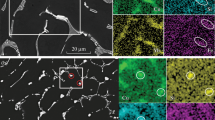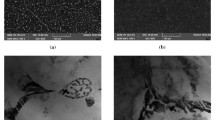Abstract–The effect of impurities of iron and silicon on the phase composition and mechanical properties of the Al–6.3Cu–3.2Y wrought aluminum alloy is investigated in this work. According to the results of X-ray diffraction of the cast alloy, the presence of Al8Cu4Y, (Al,Cu)11Y, Al2Cu, and AlCu phases was confirmed, and the presence of peaks that likely correspond to the Al11Cu2Y2Si2 phase was noted. Elongated needle-like inclusions of the Al11Cu2Y2Si2 phase, which does not change its morphology in the course of homogenization, appear against the background of the fragmented compact eutectic. At the temperatures of annealing of the deformed sheets up to 300°C, the structure of alloy is represented by grains elongated along the rolling direction and has a slightly higher hardness than the same alloy without impurities. This is caused by the presence of larger amount of sufficiently dispersed intermetallic particles in the structure. When increasing the annealing temperature, the difference in hardness between the considered alloys decreases. Recrystallization occurs starting from 350°С, the hardness of the alloys levels out. After annealings at 100 and 150°C, the studied alloy demonstrates a good level of strength characteristics, the conditional yield stress is 284–325 MPa, the conditional ultimate strength is 304–369 MPa, which is 20–30 MPa higher than in the alloy without impurities. In general, the presence of permanent impurities of iron and silicon in aluminum does not have a negative effect on the mechanical properties of the studied alloy.



Similar content being viewed by others
REFERENCES
I. I. Novikov, Hot Brittleness of Nonferrous Metals and Alloys (Nauka, Moscow, 1966) [in Russian].
D. G. Eskin, Suyitno, and L. Katgerman, “Mechanical properties in the semi-solid state and hot tearing of aluminium alloys,” Prog. Mater. Sci. 49, 629–711 (2004).
V. S. Zolotorevsky, N. A. Belov, and M. V. Glazoff, Casting Aluminum Alloys, Alcoa Technical Center (Alcoa Center, PA, 2007).
ASM Handbook. Properties and Selection: Nonferrous Alloys and Special-Purpose Materials. Vol. 2 (The Materials Information Company, 2010).
V. S. Zolotorevskiy and A. V. Pozdniakov, “Determining the hot cracking index of Al–Si–Cu–Mg casting alloys calculated using the effective solidification range,” Int. J. Cast Met. Res. 27, 193–198 (2014).
V. S. Zolotorevskiy, A. V. Pozdniakov, and A. Yu. Churyumov, “Search for promising compositions for developing new multiphase casting alloys based on Al–Cu–Mg matrix using thermodynamic calculations and mathematic simulation,” Phys. Met. Metallogr. 113, 1052–1060 (2012).
T. Krachan, B. Stel’makhovych, and Yu. Kuz’ma, “The Y–Cu–Al system,” J. Alloys Compd. 349, 134–139 (2003).
L. Zhang, P. J. Masset, X. Tao, G. Huanga, H. Luo, L. Liu, and Z. Jin, “Thermodynamic description of the Al–Cu–Y ternary system,” CALPHAD: Comput. Coupling Phase Diagrams Thermochem. 35, 574–579 (2011).
L. Zhang, P. J. Masset, F. Cao, F. Meng, L. Liu, and Z. Jin, “Phase relationships in the Al-rich region of the Al–Cu–Er system,” J. Alloys Compd. 509, 3822–3831 (2011).
L. G. Zhang, L. B. Liu, G. X. Huang, H. Y. Qi, B. R. Jia, and Z. P. Jin, “Thermodynamic assessment of the Al–Cu–Er system,” CALPHAD: Comput. Coupling Phase Diagrams Thermochem. 32, 527–534 (2008).
A. V. Pozdniakov and R. Y. Barkov, “Microstructure and materials characterisation of the novel Al–Cu–Y alloy,” Mater. Sci. Technol. 34, 1489–1496 (2018).
A. V. Pozdnyakov, R. Y. Barkov, Z. Sarsenbaev, S. M. Amer, and A. S. Prosviryakov, “Evolution of microstructure and mechanical properties of a new Al–Cu–Er wrought alloy,” Phys. Met. Metallogr. 120, 614–619 (2019).
S. M. Amer, R. Yu. Barkov, O. A. Yakovtseva, and A. V. Pozdniakov, “Comparative analysis of structure and properties of quasi-binary Al–6.5Cu–2.3Y and Al–6Cu–4.05Er alloys,” Phys. Met. Metallogr. 121, 528–534 (2020).
A. V. Pozdniakov, R. Yu. Barkov, S. M. Amer, V. S. Levchenko, A. D. Kotov, and A. V. Mikhaylovskaya, “Microstructure, mechanical properties and superplasticity of the Al–Cu–Y–Zr alloy,” Mater. Sci. Eng., A 758, 28–35 (2019).
S. M. Amer, R. Yu. Barkov, O. A. Yakovtseva, I. S. Loginova, and A. V. Pozdniakov, “Effect of Zr on microstructure and mechanical properties of the Al–Cu–Er alloy,” Mater. Sci. Technol. 36, 453–459 (2020).
Y. Zhang, H. Gao, Y. Kuai, Y. Han, J. Wang, B. Sun, S. Gu, and W. You, “Effects of Y additions on the precipitation and recrystallization of Al–Zr alloys,” Mater. Charact. 86, 1–8 (2013).
Y. Zhang, K. Gao, S. Wen, H. Huang, Z. Nie, and D. Zhou, “The study on the coarsening process and precipitation strengthening of Al3Er precipitate in Al–Er binary alloy,” J. Alloys Compd. 610, 27–34 (2014).
Y. Zhang, J. Gu, Y. Tian, H. Gao, J. Wang, and B. Sun, “Microstructural evolution and mechanical property of Al–Zr and Al–Zr–Y alloys,” Mater. Sci. Eng., A 616, 132–140 (2014).
H. Gao, W. Feng, and Y. Wang, “Structural and compositional evolution of Al3(Zr,Y) precipitates in Al–Zr–Y alloy,” Mater. Charact. 121, 195–198 (2016).
H. Gao, W. Feng, J. Gu, J. Wang, and B. Sun, “Aging and recrystallization behavior of precipitation strengthened Al–0.25Zr–0.03Y alloy,” J. Alloys Compd. 696, 1039–1045 (2017).
A. V. Pozdnyakov, A. A. Osipenkova, D. A. Popov, S. V. Makhov, and V. I. Napalkov, “Effect of Low additions of Y, Sm, Gd, Hf and Er on the structure and hardness of alloy Al–0.2% Zr–0.1% Sc,” Met. Sci. Heat Treat. 58, 537–542 (2017).
A. V. Pozdniakov, R. Y. Barkov, A. S. Prosviryakov, A. Y. Churyumov, I. S. Golovin, and V. S. Zolotorevskiy, “Effect of Zr on the microstructure, recrystallization behavior, mechanical properties and electrical conductivity of the novel Al–Er–Y alloy,” J. Alloys Compd. 765, 1–6 (2018).
H. L. Hao, D. R. Ni, Z. Zhang, D. Wang, B. L. Xiao, and Z. Y. Ma, “Microstructure and mechanical properties of Al–Mg–Er sheets jointed by friction stir welding,” Mater. Des. 52, 706–712 (2013).
Y. Dongxi, L. Xiaoyan, H. Dingyong, and H. Hui, “Effect of minor Er and Zr on microstructure and mechanical properties of Al–Mg–Mn alloy (5083) welded joints,” Mater. Sci. Eng., A 561, 226–231 (2013).
S. P. Wen, W. Wang, W. H. Zhao, X. L. Wu, K. Y. Gao, H. Huang, and Z. R. Nie, “Precipitation hardening and recrystallization behavior of Al–Mg–Er–Zr alloys,” J. Alloys Compd. 687, 143–151 (2016).
A. V. Pozdniakov, V. Yarasu, R. Yu. Barkov, O. A. Yakovtseva, S. V. Makhov, and V. I. Napalkov, “Microstructure and mechanical properties of novel Al–Mg–Mn–Zr–Sc–Er alloy,” Mater. Lett. 202, 116–119 (2017).
F. Cao, X. Zhu, S. Wang, Lu. Shi, G. Xu, and J. Wen, “Quasi-superplasticity of a banded-grained Al–Mg–Y alloy processed by continuous casting-extrusion,” Mater. Sci. Eng., A 690, 433–445 (2017).
R. Yu. Barkov, A. V. Pozdniakov, E. Tkachuk, and V. S. Zolotorevskiy, “Effect of Y on microstructure and mechanical properties of Al–Mg–Mn–Zr–Sc alloy with low Sc content,” Mater. Lett. 217, 135–138 (2018).
N. Q. Vo, D. C. Dunand, and D. N. Seidman, “Improving aging and creep resistance in a dilute Al–Sc alloy by microalloying with Si, Zr and Er,” Acta Mater. 63, 73–85 (2014).
A. De Luca, D. C. Dunand, and D. N. Seidman, “Mechanical properties and optimization of the aging of a dilute Al–Sc–Er–Zr–Si alloy with a high Zr/Sc ratio,” Acta Mater. 119, 35–42 (2016).
C. Booth-Morrison, D. N. Seidman, and D. C. Dunand, “Effect of Er additions on ambient and high-temperature strength of precipitation-strengthened Al–Zr–Sc–Si alloys,” Acta Mater. 60, 3643–3654 (2012).
A. V. Pozdniakov, A. A. Aytmagambetov, S. V. Makhov, and V. I. Napalkov, “Effect of impurities of Fe and Si on the structure and strengthening upon annealing of the Al–0.2% Zr–0.1% Sc alloys with and without Y additive,” Phys. Met. Metallogr. 118, 479–484 (2017).
A. V. Pozdnyakov and R. Yu. Barkov, “Effect of impurities on the phase composition and properties of a new alloy of the Al–Y–Er–Zr–Sc system,” Metallurgist 63, 79–86 (2019).
S. M. Amer, R. Yu. Barkov, and A. V. Pozdniakov, “Effect of impurities on phase composition and properties of Al–6% Cu–4.05% Er wrought alloy,” Phys. Met. Metallogr. 121, 1–5 (2020).
Funding
This work was financially supported by Russian Science Foundation (project no. 19-79-10242).
Author information
Authors and Affiliations
Corresponding author
Additional information
Translated by A. Bannov
Rights and permissions
About this article
Cite this article
Amer, S.M., Barkov, R.Y. & Pozdniakov, A.V. Effect of Iron and Silicon Impurities on Phase Composition and Mechanical Properties of Al–6.3Cu–3.2Y Alloy. Phys. Metals Metallogr. 121, 1002–1007 (2020). https://doi.org/10.1134/S0031918X20090021
Received:
Revised:
Accepted:
Published:
Issue Date:
DOI: https://doi.org/10.1134/S0031918X20090021




